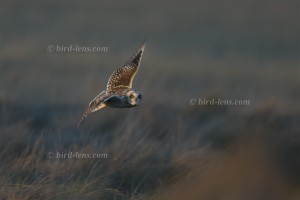 Very few people will see them in the northern German winter. A Short-eared Owl (Asio flammeus) flies over the moor in front of the dark edge of the forest with a typical rowing flap of wings. The sun has already set for half an hour. Fog rises from the moor. Soon the last glow of the setting sun will have completely disappeared in the west. Cold, wonderful winter weather has been prevailing for days.
Very few people will see them in the northern German winter. A Short-eared Owl (Asio flammeus) flies over the moor in front of the dark edge of the forest with a typical rowing flap of wings. The sun has already set for half an hour. Fog rises from the moor. Soon the last glow of the setting sun will have completely disappeared in the west. Cold, wonderful winter weather has been prevailing for days.
Suddenly a second bird appears at the edge of the forest. It follows the first owl with the same flight. They fly silently along the clearing several times. But one owl then swerves and flies off the eastern edge of the forest. Suddenly it flies towards the hide where I had already stayed for 1.5 hours. The long, rounded wings and the round head are clearly visible. Maybe the owl was attracted by ist calls I played from tape?
Although the moor may seem deserted in winter, there are still some guests in the cold season. During the last half hour of the evening a Hen Harrier (Circus cyaneus) – a female – had also flown in that evening. A Great Grey Shrike (Lanius excubitor) suddenly stood on the top of a tree far away, too.
Several moors can be found in Brandenburg in the landscapes that were still shaped by the Ice Age. They are dominated by Purple Moor Grass (Molinia caerulea) and unfortunately – also already – interspersed Pine growth (Pinus sylvestris). The area is not completely open; There are small pine trunks spread all over the area. The area, which is dominated by Purple Moor Grass, is otherwise covered with, among other things, Cotton Grass (Eriophorum vaginatum), Wild Rosemary (Ledum palustre), Bog-Rosemary (Andromeda polifolia) and Common Cranberry (Vaccinium oxycoccos).
I’ve seen short-eared owls over this particular moor a few times now. However, without a thermal imaging camera you will be unsuccessful given the lighting conditions. So far the owls have always been out and about in the last few minutes before total darkness. Even trying to glimpse them with binoculars is completely hopeless.
This could also be the reason for the few reports of short-eared owls from Brandenburg. That’s why the photo in the blog was taken with a wintering Short-eared Owl at Laguna Gallocanta in central Spain. The Short-eared Owls are there much earlier. However, the reports that come in are characterized by a certain regularity. Practically every winter there are reports from the former airport at Tempelhofer Feld in the middle of Berlin.
The wintering Short-eared Owls on the Middle Elbe, including on the Old Elbe near Bösewig east of Wittenberg, can usually be seen at dusk. However, due to the open landscape, they are much easier to discover.
To meet the growing demand for top-of-the-line images of the rarer Palaearctic species, Bird-lens.com strives to expand the range of images of Western Palaearctic birds. Trips to many locations to take pictures of rare western Palearctic birds have been very successful. This nice picture of the blog is just a first impression of what you can find in the gallery of the “Picture Shop” very soon. Please leave a message if bird-lens.com can provide a picture.